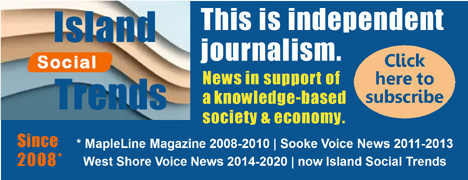Thursday January 26, 2023 | LANGFORD, BC
by Mary P Brooke | Island Social Trends
What emergency preparedness specialists refer to as ‘the big one’ happened on this date exactly 323 years ago.
The Magnitude 9 (M9) Cascadia Megathrust Earthquake of January 26, 1700 happened at night — at 9 pm — and is considered to be one of the largest earthquakes along the west coast of North America.
The quake struck from Vancouver Island to northern California. It caused the entire Pacific Northwest coastline to suddenly drop 3 to 6 feet and sent a 33-ft tsunami across the ocean to Japan.
That was before electric light at night, but it was about 48 hours past the full moon (a super moon that month) so perhaps there was enough outdoor light for people to manage in the moment.
Reminder in January, and October:
On Vancouver Island yesterday there was a low-key reminder of the big event — including a post on social media by Juan de Fuca Emergency Program.
The annual Great BC Shakeout is a province-wide earthquake preparedness drill (part of an international drill) is held in October. In its first few years, that drill is held at 10:17 am, to remind about January (first month) in the 1700s. Or, if the date is adjusted — like last year with the Shakeout BC held on October 19, the time is promoted at 10:19 am.
The next quake of magnitude 9 or greater is expected to occur within about 500 years of the last one. That leaves a window of about 177 years before the next one. But this is based on estimates.
Records of the Cascadia thrust:
The undersea Cascadia thrust fault ruptured along a 1,000 km length, from mid Vancouver Island to northern California in a great earthquake, producing tremendous shaking and a huge tsunami that swept across the Pacific. The Cascadia fault is the boundary between two of the Earth’s tectonic plates: the smaller offshore Juan de Fuca plate that is sliding under the much larger North American plate.
It is recorded in oral traditions of the First Nationals people on Vancouver Island:
- The earthquake shaking collapsed houses of the Cowichan people on Vancouver Island and caused numerous landslides. The shaking was so violent that people could not stand and so prolonged that it made them sick.
- On the west coast of Vancouver Island, the tsunami completely destroyed the winter village of the Pachena Bay people with no survivors.
The tsunami swept across the Pacific also causing destruction along the Pacific coast of Japan. It is the accurate descriptions of the tsunami and the accurate time keeping by the Japanese that allows us to confidently know the size and exact time of this great earthquake.
The earthquake also left unmistakable signatures in the geological record as the outer coastal regions subsided and drowned coastal marshlands and forests that were subsequently covered with younger sediments.
The recognition of definitive signatures in the geological record tells us the January 26, 1700 event was not a unique event, but has repeated many times at irregular intervals of hundreds of years. Geological evidence indicates that 13 great earthquakes have occurred in the last 6,000 years.
Natural Resources Canada says: “We now know that a similar offshore event will happen sometime in the future and that it represents a considerable hazard to those who live in southwest BC.”
“However, because the fault is offshore, it is not the greatest earthquake hazard faced by major west coast cities. In the interval between great earthquakes, the tectonic plates become stuck together, yet continue to move towards each other. This causes tremendous strain and deformation of the Earth’s crust in the coastal region and causes ongoing earthquake activity. This is the situation that we are in now,” it is stated on the Natural Resources Canada page about the 9.0 Magnitude quake in 1700.
Urban hazard:
Some onshore earthquakes can be quite large: there have been four magnitude 7+ earthquakes in the past 130 years in southwest BC and northern Washington State.
Because these inland earthquakes can be much closer to our urban areas and occur more frequently, they represent the greatest earthquake hazard.
An inland magnitude 6.9 earthquake in 1995 in a similar geological setting beneath Kobe, Japan caused in excess of $200 billion damage.
Preparing for earthquakes:
In populated areas the preparation for earthquakes involves practicing drop-cover-hold on, and preparing both a primary emergency kit (kept in a central location, preferably outdoors in a shed or garage) as well as grab-and-go bags for each member of the household (and in multiple locations like home, car and workplace), including for pets, says Juan de Fuca Emergency Program Coordinator Jeri Grant.
Prepare your kits for at least 72 hours, but for as long as a week or even 10 days, for bigger emergencies.
Tips for emergency preparation and keeping your emergency kits up to date are posted by the Juan de Fuca Emergency Program on Twitter.
Emergencies in this region:
Emergencies in this region include earthquake, tsunami, extreme heat, severe weather, power outages, forest fires, and more.
The Capital Regional District’s Prepare Yourself emergency information website at prepareyourself.ca covers a wide range of emergency preparedness topics including earthquake preparedness.
The Natural Resources Canada earthquake preparedness page includes a section on minimizing earthquake damage to your home.
===== ABOUT ISLAND SOCIAL TRENDS:
Island Social Trends emerged in mid-2020 from a preceding series of publications edited by Mary P Brooke and published by Brookeline Publishing House Inc. The series which led to Island Social Trends: MapleLine Magazine (2008-2010), Sooke Voice News (2011-2013), and West Shore Voice News (2014-2020). | ARCHIVES: Vancouver Island | Emergency Preparedness & Safety










